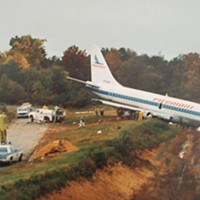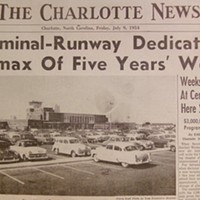A million lights webbed over black earth as we radioed Nashville approach and explained our predicament. The controller's tinny voice crackled across the night sky as our little Apache airplane thrummed toward Nashville International Airport.
"Roger," he said coolly. "Expect runway two-zero center."
My flight instructor Volker and I exchanged a glance. Shouldn't the controller have said something, I don't know, comforting?
"You do understand," reiterated Volker, "we're coming in with a broken nose wheel."
"Affirmative," said the controller. "We'll have equipment ready."
Most aircraft incidents that make the evening news are fast-moving, catastrophic and often caused by pilot error. The one that befell the small twin-engine airplane we were flying that fall evening 18 years ago was none of these. Which is why, when the air traffic controller asked if we wanted to declare an emergency, Volker and I swapped another quizzical glance before transmitting our answer.
Was it an emergency? It had all begun so quietly an hour before, when a green light on the dash failed to illuminate, indicating a possible nose wheel malfunction. I fully expected Volker to take over the Apache's controls and magically fix the problem.
Instead, he calmly continued the flight lesson, as if this were just another simulated emergency. "OK, what do we do now?" he said.
"Go around. Recycle the gear," I suggested. He nodded. I raised the gear lever and put a few thousand feet of air between us and the ground, which lay in wait. As the horizon reddened, we reviewed everything he'd taught me to do when a nose wheel fails to lock down: Fly slow and lower the gear again. Swap out the little green bulbs. Try the manual gear pump. Do wild maneuvers to try to snap the nose wheel in place using G-forces.
None of these procedures had any effect. With time and fuel to burn, Volker and I discussed what to do next, then decided to ask the fuel guy at John Tune, our home airport, to eyeball the undercarriage as we did a low pass. "Looks like the nose wheel's dangling at a weird angle," he radioed back.
"What do you think?" said Volker, still instructing, as we climbed to a safe altitude.
"Maybe we should land at Nashville?" I ventured. "They've got emergency equipment and everything." He waved that off, as if this wee little emergency couldn't possibly merit medical or fire crews. Still, we banked east toward BNA.
Here's the thing about a gear failure: It's not a problem until you land. There's time to think. But finally, having exhausted the emergency checklist, we aimed for BNA's beacon and considered the looming eventuality of returning to earth.
The last moments of that flight were eerily beautiful: the airport's manic shapes traced in dots of light; the insistent flash of emergency vehicles; the absence of any engine noise. On final, Volker had elected to shut down both engines and halt the propellers' spinning, to keep them from slicing into the tarmac. The only sound was air whooshing over wings.
As we glided toward the lights, I wondered how much of an emergency this was likely to be — a forehead-bruiser or an ER visit?
And then it was time. As we touched down on the main wheels, Volker hauled back on the yoke, holding the nose up as long as he could. And then: Sparks. Noise. Flashing lights. After that, just flashing lights.
His landing was masterful. No ER trip, no bruises, not even newsworthy, though the news crews came anyway. We slid down the wing and spent the next few hours joking with firemen, admiring the tidy chalk line Volker had drawn down the runway centerline using his Apache's ground-down nose cone.
I was more in awe of my instructor than ever. I resolved to be him. Through it all, he had simply proceeded with the flying lesson. I'd searched his face for signs of fear and found nothing but unruffled confidence. And because he wasn't afraid, neither was I. His logbook entry was similarly understated: "Interesting flight," it read.
A few years later, I was a flight instructor, teaching at BNA in my own Cessna 172. I was no Volker, but I flew safely and was — I hope — patient and calm with students. But where Volker was brilliant and confident, I felt, I was merely competent, and certainly not immune to occasional fears and doubts. Then came my second "interesting flight," this one faster-paced. At the end of a routine lesson, the plane's engine went BANG over Percy Priest Lake. We'd thrown a valve; the little plane shook violently as the engine's steady rock beat lurched into a lunatic tango.
My brain went quiet and focused. "I've got the plane," I told John, my student. "You call Nashville approach and declare an emergency."
We headed for the airport and hoped.
Our wounded engine survived long enough to carry us to safety — unhurt, and mostly unruffled. After, I asked John what the experience was like for him. "I was never afraid we were going to fall out of the sky and die or anything," he said. "You had control of the situation."
That was nice to hear. But maybe it's best that John didn't notice this small detail: As I stepped out onto the airport ramp, my legs sewing-machined like mad against the tarmac, jangling with adrenaline.
My logbook entry for that day: "Power loss."
Speaking of...
Latest in Vodka Yonic
More by Kim Green
-

Back in the USSR
May 7, 2015 -

An open letter to the good guys
Feb 19, 2015 -

Mansplainers Anonymous
Feb 11, 2015 - More »
Calendar
-

Charlotte Wine & Food Week’s Annual Sake Dinner at Mizu @ Mizu
-

Hands On Cocktail Class Featuring Gin at DTR Southpark @ DTR SouthPark
-

Wine & Paint @ Blackfinn Ameripub- Ballantyne
-

Aria Tuscan Grill Featuring Allegrini - Charlotte Wine + Food Week @ Aria Tuscan Grill
-

Angeline’s Featuring Sciandri Family Vineyards @ Angeline's
-
A Beginners Guide To Fishing 1
-
Today's Top 5: Wednesday
Here are the five best events going down in Charlotte and the surrounding area today.
-
5 profitable business ideas in the cannabis industry 12













